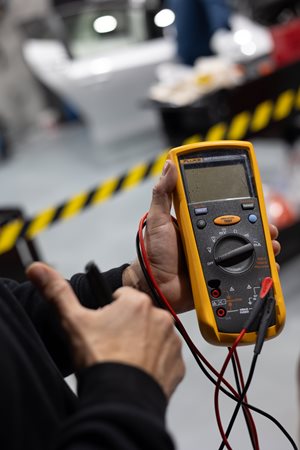SuniTAFE strives to be an industry leader in promoting the safe and informed handling of electric and hybrid vehicles.
While it is known that these vehicles are better for our environment, they also provide new risks for those who must diagnose and repair them.
SuniTAFE’s Hybrid and Electric Vehicle short course (SCAUR30620HE) is designed to show students how to safely work on electric and hybrid vehicles and to help them understand how these vehicles operate.
The most recent offering of this short course, which ran in mid-June 2023, was attended by individuals from across Victoria. Several students travelled from as far away as Melbourne to complete the course at SuniTAFE.
This is an indication of SuniTAFE’s high level of training, and the Automotive Department’s commitment to what Education Delivery Manager – Automotive, Transport, and Logistics Terry Sparrow refers to as best practice.
“What we try to teach is best practice. This means that while you don’t necessarily need to do everything that we do, or use all of the high-end equipment that we use, it is recommended to get the best and safest results,” Terry said.
The students who undertake this short course are often well-established members of industry with successful businesses who are looking to gain the most relevant skillsets. The feedback from these industry participants on SuniTAFE’s equipment and education delivery has been positive.
Vijay Saini, owner of Saini Automotive in Mildura, completed SuniTAFE’s Hybrid and Electric Vehicle short course in December last year. Since then, he has been able to expand his services and offer repairs of hybrid and electric vehicles.
“Before this short course we were not authorised or trained to work on hybrid or electric vehicles. We didn’t know what the voltage would be in these systems, how to connect and disconnect them, and even which kinds of tools were safest to use,” Vijay said
“Now, we see these kinds of cars every day and we are very confident to work on them. We have a very good understanding.”
A pivotal component of understanding hybrid and electric vehicles is knowing which tools and equipment are going to be the safest.
As part of the short course, students are shown 1000V insulated tools. These are common tools, such as a spanner or wrench, which are insulated to prevent dangerous consequences such as electrocution.
Students also get to use a thermal imaging gun, which can help to identify and diagnose problems in an electric or hybrid vehicle, such as a short in an electrical circuit.
The short course also demonstrates how to use an insulation multimeter. This piece of equipment allows students to identify problems in an electric or hybrid vehicle. This differs from the insulation testers used by standard mechanics, as it can measure up to 1000 volts, which is required for electric and hybrid vehicles.
Finally, the students are made to wear specialised gloves with three layers of insulation, as well as stand on insulated mats, as further safety measures to prevent electrical shock.
Vijay was impressed by the equipment he used during his time at SuniTAFE.
“Electric vehicles have a lot of high voltage parts and that can be very dangerous for us. The equipment that I used during the short course was very good and kept us safe at all times,” he said.
“To make sure I protect myself and my team, I bought the same tools for my workshop and created the exact same setup.”
SuniTAFE’s Automotive Department hopes to have a similar impact on many more students, and lead the industry in electric and hybrid vehicle safety and expertise.
Click here to read about another way SuniTAFE is preparing its Automotive students for a more sustainable future.

